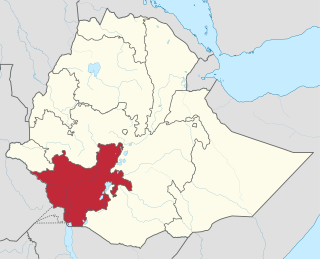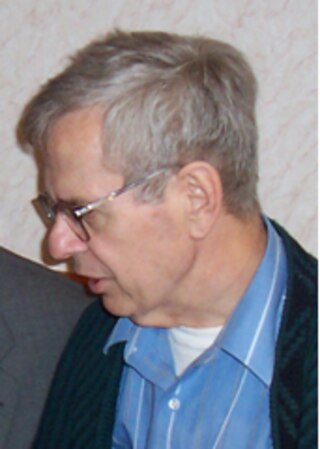Related Research Articles

The Cushitic languages are a branch of the Afroasiatic language family. They are spoken primarily in the Horn of Africa, with minorities speaking Cushitic languages to the north in Egypt and Sudan, and to the south in Kenya and Tanzania. As of 2012, the Cushitic languages with over one million speakers were Oromo, Somali, Beja, Afar, Hadiyya, Kambaata, and Sidama.

The Southern Nations, Nationalities, and Peoples' Region was a regional state in southwestern Ethiopia. It was formed from the merger of five kililoch, called Regions 7 to 11, following the regional council elections on 21 June 1992. Its government was based in Hawassa.
Avoidance speech is a group of sociolinguistic phenomena in which a special restricted speech style must be used in the presence of or in reference to certain relatives, or in certain situations. Avoidance speech is found in many Australian Aboriginal languages and Austronesian languages as well as some North American languages such as Anishinaabe-mowin, Highland East Cushitic languages and Southern Bantu languages. Chinese naming taboo prohibits speaking and writing syllables or characters that appear in the names of esteemed people, such as emperors, parents, and ancestors.
Sidama or Sidaamu Afoo is an Afro-Asiatic language belonging to the Highland East Cushitic branch of the Cushitic family. It is spoken in parts of southern Ethiopia by the Sidama people, particularly in the densely populated Sidama National Regional State (SNRS). Sidaamu Afoo is the ethnic autonym for the language, while Sidaminya is its name in Amharic. It is not known to have any specific dialects. The word order is typically SOV. Sidaama has over 100,000 L2 speakers. The literacy rate for L1 speakers is 1%-5%, while for L2 speakers it is 20%. In terms of its writing, Sidaama used an Ethiopic script up until 1993, from which point forward it has used a Latin script.

The languages of Ethiopia include the official languages of Ethiopia, its national and regional languages, and a large number of minority languages, as well as foreign languages.
Libido is an Afroasiatic language of Ethiopia, which is spoken in the Mareko district Gurage Zone of the Southern Nations, Nationalities, and Peoples' Region, directly south-east of Butajira. According to the information of the Central Statistical Authority (2007) census, 59,000 people speak the language as mother tongue.

Kambaata is a Cushitic ethnic group in south-central Ethiopia, specifically in Kambaata Zone in Central Ethiopia Regional State. It is also known as Cambat, Kambata, Cambatta, Kambatta or Khambat by various historians and early explorers. The Kambaata people and Kambaatissa belongs to the East Highland Cushitic language family. Kambaata was first mentioned in the chronicles of Emperor Yeshaq I. Kambaata was "one of the southern kingdoms with well-established monarchical system...instituted in 16th century and operated without interruption until it ended at the last decade of ninetieth century" when it was incorporated by Emperor Menelik II. During this first period incorporation, Kambaata province was largely Christianized.

The Sidama Region is a regional state in southern Ethiopia. It was formed on 18 June 2020 from the Southern Nations, Nationalities, and Peoples' Region (SNNPR) and transformation of the Sidama Zone after a 98.52% vote in favour of increased autonomy in the 2019 Sidama referendum. It is the second smallest regional state in the country, after Harari. Sidama is the name of both the Sidama people, the language, and the territory. Sidama is bordered to the south by the Oromia Region (except for a short stretch in the middle where it shares a border with Gedeo zone, in South Ethiopia Regional State, on the west by the Bilate River, which separates it from Wolayita Zone, and on the north and east by the Oromia Region. Towns in Sidama include Hawassa, the capital of Sidama and of SNNPR when it existed, Yirgalem, Wondogenet, Chuko, Hula, Bona, Bursa, Bensa, and Aleta Wendo. Sidama has a population of around 3.2 million in 2017 who speak the Cushitic language Sidama.
Hadiyya is the language of the Hadiya people of Ethiopia. Over 1.2 million speakers of Hadiyya, making it one of the ten major languages in Ethiopia. It is a Highland East Cushitic language of the Afroasiatic family. Most speakers live in the Hadiya Zone of the Southern Nations, Nationalities, and People's Region (SNNPR). The language has four recognized dialects—Leemo, Badawacho, Shashogo, and Sooro. These are mutually intelligible, with slight regional variations.

Marvin Lionel Bender was an American linguist.
Burji language is an Afro-Asiatic language spoken by the Burji people who reside in Ethiopia south of Lake Chamo. There are over 49,000 speakers in Ethiopia, and a further 36,900 speakers in Kenya. Burji belongs to the Highland East Cushitic group of the Cushitic branch of the Afro-Asiatic family.
Gedeo is a Highland East Cushitic language of the Afro-Asiatic family spoken in south central Ethiopia. Alternate names for the language include Derasa, Deresa, Darassa, Geddeo, Derasanya, Darasa. It is spoken by the Gedeo people, who live in the highland area, southwest of Dila and east of Lake Abaya.
Alaba-Kʼabeena, also known as Wanbasana, is a Highland East Cushitic language spoken in Ethiopia by the Halaba and Kebena people in the Great Rift Valley southwest of Lake Shala, specifically in Alaba special district, the Kebena district of Gurage Zone, and the Goro district of Oromia Region. The literacy rate of native speakers in their language is below 1%, while their literacy rate in second languages is 8.6%; Alaba-Kʼabeena is taught in primary schools. It has an 81% lexical similarity with Kambaata. However, Fleming (1976) classifies Kʼabeena as a dialect of Kambaata, and Blench (2006) classifies both as dialects of Kambaata. The 2007 census in Ethiopia lists Alaba and Qebena as separate languages.
Kambaata is a Highland East Cushitic language, part of the larger Afro-Asiatic family and spoken by the Kambaata people. Closely related varieties are Xambaaro, Alaba, and Qabeena (K'abeena), of which the latter two are sometimes divided as a separate Alaba language. The language has many verbal affixes. When these are affixed to verbal roots, there are a large amount of morphophonemic changes. The language has subject–object–verb order. The phonemes of Kambaata include five vowels, a set of ejectives, a retroflexed implosive, and glottal stop.
The Ethiopian language area is a hypothesized linguistic area that was first proposed by Charles A. Ferguson, who posited a number of phonological and morphosyntactic features that were found widely across Ethiopia and Eritrea, including the Ethio-Semitic, Cushitic and Omotic languages but not the Nilo-Saharan languages.
The East Cushitic languages are a branch of Cushitic within the Afroasiatic phylum. Prominent East Cushitic languages include Oromo, Somali, and Sidama. The unity of East Cushitic has been contested: Robert Hetzron suggested combining the Highland East Cushitic languages with the Agaw languages into a "Highland Cushitic" branch, while most other scholars follow Martino Mario Moreno in seeing Highland and Lowland as two branches of East Cushitic.
The Halaba people are an ethnic group inhabiting the central Ethiopian highlands. The Halaba claim to originate from the Arab cleric, Abadir who settled in Harar. In the middle ages, Halaba were part of the Hadiya state. In the 1400s, their Garad (chief) was in conflict with the Abyssinian monarch Zara Yaqob. They are mostly Muslims but there are also some Christians. A map of the region from 1628 shows a Kingdom of Halaba. They speak Halaba-Kʼabeena which is a member of the Highland East Cushitic languages within the Afroasiatic family. Sidi Mohammed the Garad of Hadiya is stated to be a forefather for the Halaba people.
Grover M. Hudson was an American linguist and Professor Emeritus of Linguistics, Germanic, Slavic, Asian and African Languages at Michigan State University. He was known for his works on the Amharic language.

Cushitic-speaking peoples are the ethnolinguistic groups who speak Cushitic languages natively. Today, the Cushitic languages are spoken as a mother tongue primarily in the Horn of Africa, with minorities speaking Cushitic languages to the north and south in Egypt, Sudan, Kenya, and Tanzania.
Proto-Cushitic is the reconstructed proto-language common ancestor of the Cushitic language family. Its words and roots are not directly attested in any written works, but have been reconstructed through the comparative method, which finds regular similarities between languages not explained by coincidence or word-borrowing, and extrapolates ancient forms from these similarities.
References
- Hudson, Grover. 1981. The Highland East Cushitic family vine. Sprache und Geschichte in Afrika 3.97-124.
- Hudson, Grover. 1988. The Highland Cushitic hypothesis. Proceedings of the Eighth International Conference of Ethiopian Studies (Addis Ababa, 1984), Taddese Beyene, ed., 693-696. Birmingham, England: Elm Press.
- Hudson, Grover. 1989. Highland East Cushitic Dictionary (Kuschitische Sprachstudien 7). Hamburg: Buske.
- Hudson, Grover. 2005. Highland East Cushitic languages, Encyclopedia of Language and Linguistics, 2nd ed., Keith Brown, ed., 294-298. Elsevier: Oxford.
- Hudson, Grover. 2007a. Highland East Cushitic morphology, Morphologies of Asian and African Languages, vol. 1, Alan S. Kaye, ed., 529-545. Winona Lake, IN: Eisenbrauns.
- Sasse, Hans-Jürgen. 1979. The consonant phonemes of Proto-East-Cushitic (PEC): A first approximation. Malibu: Undena Publications.
- Wedekind, Klaus. 1980. Sidamo, Gedeo (Derasa), Burji: Phonological differences and likenesses. Journal of Ethiopian Studies 14: 131-76.
- Wedekind, Klaus. 1990. Generating narratives: interrelations of knowledge, text variants, and Cushitic focus strategies. Trends in Linguistics. Studies and Monographs, 52. Berlin: Mouton de Gruyter.